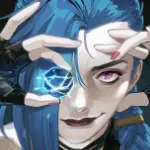When I first heard about this Nosferatu remake my first two thoughts were "Another Dracula adaptation?" and “Why is Eggers wasting his time on this?”. And while I still kind of wish Eggers had done some of the original thinking he must have done, I have to admit that he was the right choice to take on this project and he did it very well.
One of the reasons for this is the obvious one: the big changes to the story, like the vampire being summoned by Hellen and that being the reason for his obsession with her instead of him simply finding her attractive or her being the reincarnation of his old love. With this innovation in the story, a strong component of sexual domination also appears that was not so present in other versions and places Orlok as a predator in several senses.
And another reason is how the director "fixed" some of the weakest points of the adaptations of the famous monster, such as giving the role that Renfield usually occupies to the real estate owner (saving a character) or better explaining the Count's reasons for wanting to travel to England by showing that he needs to go to a less superstitious place where he can lurk more calmly.

But if there's one thing that really made this remake stand out, are the details. By now, after making “The Witch”, “The Lighthouse”, and “The Northman”, it's clear that Eggers likes making period films, and it's known to film buffs that he does a lot of research to represent the beliefs of those moments in history as faithfully as possible. And although we are not aware of all this historical precision until we start reading about the films after watching them, they create a climate of greater verisimilitude where one can come to believe that these are real stories that happened in the past.
These are some of the details in Nosferatu that I liked the most:
- The gypsy ritual

This was one of my favorite scenes in the movie, because I had no idea where it was going, in no previous adaptation had we had a group of gypsies performing a strange ritual so it caught me very off guard.
According to Eastern European folklore a white horse ridden by a virgin or child (due to their purity) would not tread on a vampire's grave, allowing them to find and kill one. Furthermore, the crooked grave is also another indication that there is a vampire underneath, as it is a sign that the earth is unstable because it was disturbed by the creature coming and going.
And something that makes the scene even more interesting is the ambiguity of whether they actually killed a vampire, since at no point do they show us that Orlok can convert others or that there are more like him, so it may have simply been a swollen corpse that, when stabbed, spat out the accumulated blood.
- The way to suck blood

We are very used to vampires sucking the blood of their victims from the neck, but this was not always the case in the beliefs surrounding these creatures. In ancient times, bloodsucker attacks were associated with sleep paralysis, and it was believed that they sat on the chest of their victims to suffocate them and drink blood from their hearts. Furthermore, they did not drink blood out of necessity for survival, but out of pure evil and pleasure.
- The biblical passage of the Apocalypse

There is a moment in the film where a man recites the Bible passage Revelation 13:1, where the apostle John speaks about the vision of a beast emerging from the sea and bringing chaos, death and the end of days. We can clearly make an association between this quote and Orlok's arrival on the ship carrying rats and diseases to Germany, his mere presence in the city seems to be slowly leading it to ruin.
This association of Nosferatu with apocalyptic figures also comes from ancient beliefs that saw vampires as harbingers of famine and disease, who were there either as divine punishment or because the creature's spirit had been corrupted.
- The meeting at the crossroads

When Thomas travels to the Count's castle he is taken there by a carriage that seems to come out of nowhere in the middle of a crossroads. This is because it is generally believed that these are the auspicious places to invoke the Devil, as they symbolize the crossing between two worlds.
- Orlok as a solomonari

There is a moment in the film where a nun tells the origin of Orlok saying that he was a kind of sorcerer, which led some people on the internet to put different pieces together and deduce that he was surely a solomonari. The solomonari are sorcerers from Romanian folklore with power over nature, dragons and supernatural forces, who were neither entirely good nor evil.
That Nosferatu is an ancient Solomonari would explain his power over the weather, which we can see when he summons a storm so that the winds help the ship reach Germany faster.
- The appearance of the Count

The new Nosferatu's appearance is a far cry from previous versions, featuring a controversial mustache that some viewers found comical. This is because it's the look worn by Transylvanian nobility at the time, which also makes him similar to Vlad the Impaler, who inspired the Dracula myth.
His rotten, dead-looking body also refers to Slavic vampire myths, where vampires did not have the healthy, regenerated appearance they have today.

There are undoubtedly many more similar details in the film, and I invite you to comment if you know of any I've missed. For now, I'm eagerly awaiting Eggers' foray into werewolf mythology in his next film, to see how different these beasts are from what we know now, as he must already be reading lycanthropic myths from A to Z.
- If you like theories about movies and series, I invite you to follow me on Instagram where I compile the best ones: @TheBigCinemaTheories
























































View replies 0
View replies 0